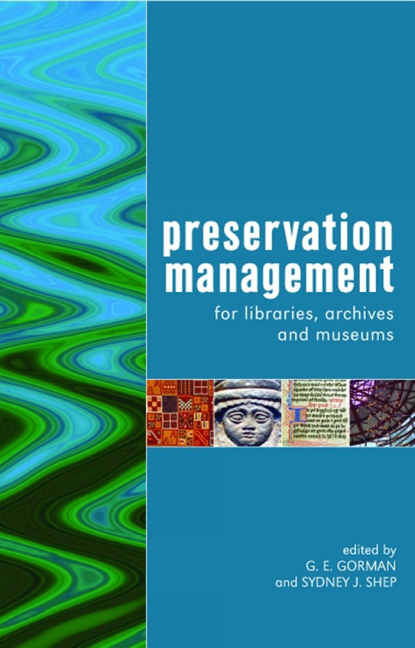Book contents
- Frontmatter
- Contents
- About the contributors
- Introduction
- 1 Managing the documentary heritage: issues for the present and future
- 2 Preservation policy and planning
- 3 Intangible heritage: museums and preservation
- 4 Surrogacy and the artefact
- 5 Moving with the times in search of permanence
- 6 Valuation model for paper conservation research: a new approach for setting research priorities
- 7 Preservation of audiovisual media: traditional to interactive formats
- 8 Challenges of managing the digitally born artefact
- 9 Preserving cultural heritage in times of conflict
- 10 Access and the social contract in memory institutions
- 11 Redefining ‘the collection’ in the 21st century
- Index
2 - Preservation policy and planning
Published online by Cambridge University Press: 08 June 2018
- Frontmatter
- Contents
- About the contributors
- Introduction
- 1 Managing the documentary heritage: issues for the present and future
- 2 Preservation policy and planning
- 3 Intangible heritage: museums and preservation
- 4 Surrogacy and the artefact
- 5 Moving with the times in search of permanence
- 6 Valuation model for paper conservation research: a new approach for setting research priorities
- 7 Preservation of audiovisual media: traditional to interactive formats
- 8 Challenges of managing the digitally born artefact
- 9 Preserving cultural heritage in times of conflict
- 10 Access and the social contract in memory institutions
- 11 Redefining ‘the collection’ in the 21st century
- Index
Summary
Introduction
This chapter discusses preservation policy, strategy and planning for libraries and archives. It argues the case for a preservation policy, indicates how preservation is linked to a number of library and archive functions, and gives guidance for formulating a preservation policy. Planning for preservation programmes is based on such a policy, and criteria for selection for preservation and for priority setting, as well as costing and monitoring of programmes, record keeping and reporting, are discussed. A good basis for preservation planning is the assessment of risks faced by buildings and collections, both every day and in extreme circumstances. Finally, risk assessment is explained and a brief outline is given of disaster prevention and disaster management.
Policy
A preservation policy is a plan of action for the safe keeping of library and archive materials. It is preferably written, but not set in stone: a living document, to be used, checked, and revised if and when the need arises. It states what needs to be preserved, why, for what purpose, and for how long. It differs from a preservation strategy – the management of all the tools and skills at our disposal to fight against damage and decay – which sets out how and in what order material is to be preserved.
For several decades libraries and archives have been aware of the need to have preservation policies, not only to raise and maintain awareness of preservation issues among staff and users, but also to bid for funds, to demonstrate that funds will be used in a responsible way and to long-term good effect, and to justify expenditure. Preservation policies are a visible expression of intent, they are signs of accountability, and they allocate responsibility to the governors, staff and users of an institution; they can explain why decisions are taken and why certain actions are or are not carried out; they are used to allocate funding, develop preservation strategies and plan coherent preservation programmes, programmes that add up to an overall useful result, taking into account the needs and benefits of the collections; they can be monitored and they form benchmarks against which performance can be judged.
- Type
- Chapter
- Information
- Publisher: FacetPrint publication year: 2006
- 1
- Cited by

